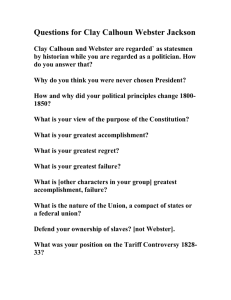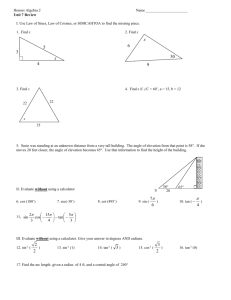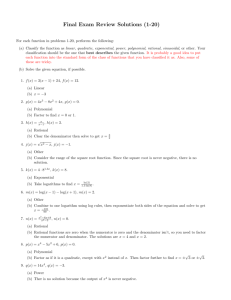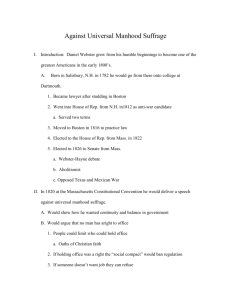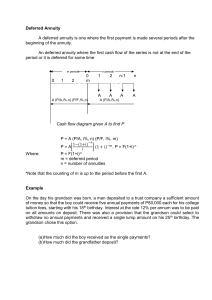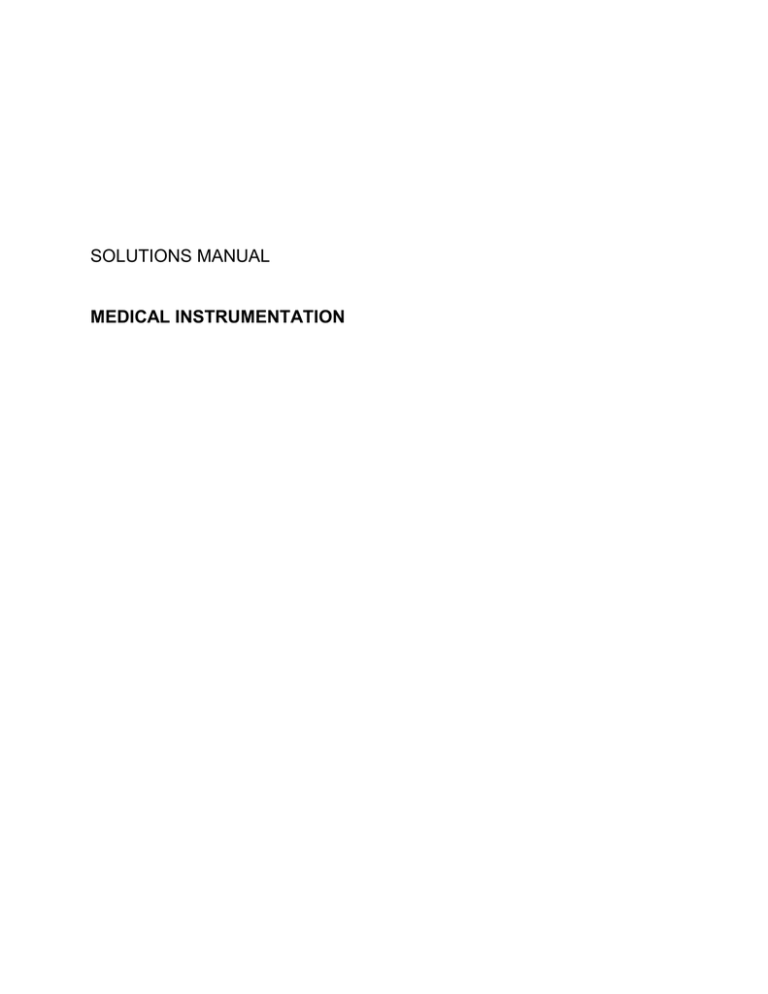
SOLUTIONS MANUAL
MEDICAL INSTRUMENTATION
SOLUTIONS MANUAL
MEDICAL INSTRUMENTATION:
Application and Design
Fourth Edition
John G. Webster, Editor
Contributing Authors
John W. Clark
Rice University
Michael R. Neuman
Michigan Technological University
Walter H. Olson
Medtronic, Inc.
Robert E. Peura
Worcester Polytechnic Institute
Frank P. Primiano, Jr.
Consultant
Melvin P. Siedband
University of Wisconsin–Madison
John G. Webster
University of Wisconsin–Madison
Lawrence A. Wheeler
Nutritional Computing Concepts
John Wiley & Sons, Hoboken, NJ
Copyright © 2009 by John Wiley & Sons, 111 River Road, Hoboken, NJ 07030.
All rights reserved.
Contents
Chapter
1
Basic Concepts of Instrumentation
6
Chapter
2
Basic Sensors and Principles
10
Chapter
3
Amplifiers and Signal Processing
16
Chapter
4
The Origin of Biopotentials
22
Chapter
5
Biopotential Electrodes
32
Chapter
6
Biopotential Amplifiers
42
Chapter
7
Blood Pressure and Sound
56
Chapter
8
Measurement of Flow and Volume of Blood
64
Chapter
9
Measurements of the Respiratory System
72
Chapter 10
Chemical Biosensors
83
Chapter 11
Clinical Laboratory Instrumentation
84
Chapter 12
Medical Imaging Systems
86
Chapter 13
Therapeutic and Prosthetic Devices
91
Chapter 14
Electrical Safety
102
Preface
Solutions were prepared by the contributing authors and compiled by the editor. We welcome
your suggestions for corrections and improvements for subsequent editions and printings. In
particular, send any lists of homework problems and examination questions that you have found
instructive to the editor John G. Webster or in the care of John Wiley & Sons, 111 River Street,
Hoboken, NJ 07030. PowerPoint slides, instructional objectives, lab instructions, and old exams
are at http://ecow.engr.wisc.edu/cgi-bin/get/bme/462/webster/
John G. Webster
Webster@engr.wisc.edu
February 7, 2009
Chapter 1
Basic Concepts of Medical Instrumentation
Walter H. Olson
1.1
The following table shows % reading and % full scale for each data point. There
is no need to do a least squares fit.
Inputs
Outputs
Ideal Output
Difference
% Reading
Full Scale
0.50
0.90
1.00
– 0.10
11.1
– 0.5%
1.50
3.05
3.00
+0.05
1.6 %
0.25%
2.00
4.00
4.00
0.0
0%
0%
5.00
9.90
10.00
– 0.10
– 1.0%
– 0.50%
10.00
20.50
20.00
+0.50
+2.4 %
+ 2.5%
= Difference/Output × 100
= Difference/20 × 100
Inspection of these data reveals that all data points are within the "funnel" (Fig.
1.4b) given by the following independent nonlinearity = ±2.4% reading or ±0.5% of full scale,
whichever is greater. Signs are not important because a symmetrical result is required. Note that
simple % reading = ±11.1% and simple % full scale = 2.5%.
1.2
The following table shows calculations using equation (1.8).
Inputs Xi
Outputs Yi
Xi – 𝑋̅
0.50
0.90
– 3.3
– 𝑌̅
(Xi – 𝑋̅)(Yi – 𝑌̅)
(Xi – 𝑋̅)2
(Yi – 𝑌̅)2
Yi
𝑋̅ = 3.8
𝑌̅ = 7.6
1.50
3.05
– 2.3
2.00
4.00
– 1.8
5.00
9.90
1.2
10.00
20.50
6.2
– 6.7
– 4.55
– 3.6
2.3
12.9
22.11
10.465
6.48
2.76
79.98
5.29
3.24
1.44
38.44
12.96
5.29
166.41
10.89
44.89
20.7
121.795
r = (7.701)(15.82) = 0.9997
1.3
The simple RC high-pass filter:
I
C
+
Vin
-
R
+
Vout
-
The first order differential equation is:
d x(t) – y(t)
y(t)
C
=
dt
R
1
CD +
y(t) = (CD) x(t)
R
y(D)
D
=
Operational transfer function
x(D)
1
D+
RC
Y(j)
X(j)
=
jRC
jRC + 1
=
RC
(RC)2 + 1
= Arctan
1
RC
;where 1/RC is the corner frequency in rad/s.
1.4
For sinusoidal wing motion the low-pass sinusoidal transfer function is
Y(j)
K
=
X(j)
(j + 1)
For 5% error the magnitude must not drop below 0.95 K or
K
K
=
= 0.95 K
2 2
j + 1
+1
Solve for with = 2f = 2(100)
2 2
( + 1) (.95)2 = 1
=
1 – (0.95)2
1/2
= 0.52 ms
(0.95)2(2100)2
Phase angle = tan–1 (–) at 50z
50 = tan–1 (–2 50 0.0005) = –9.3
at 100 Hz
100 = tan–1 (–2 100 0.0005) = –18.2
1.5
The static sensitivity will be the increase in volume of the mercury per C
divided by the cross-sectional area of the thin stem
V
K = Hg b = 2mm/C
Ac
where
cm
= 1.82 10 –4
HgVb
3
3
cm C
Vb = unknown volume of the bulb
Ac = cross-sectional area of the column
Ac = π(0.1 mm)2 = π × 10–4 cm2
Thus
Vb =
AcK
Hg
2
=
10 –4cm 0.2 cm/C
1.82 10 –4
cm
3
= 0.345 cm
3
3
cm C
1.6
Find the spring scale (Fig. 1.11a) transfer function when the mass is negligible.
Equation 1.24 becomes
dy(t)
B
+ Ks y(t) = x(t)
dt
When M = 0. This is a first order system with
1
K = static sensitivity = K
s
B
= time constant = K
s
Thus the operational transfer function is
1/Ks
y(D)
1
=
=
x(D)
B
Ks + BD
1+
D
Ks
and the sinusoidal transfer function becomes
y(j)
1/Ks
1/Ks
B
=
=
= tan–1 –
B
Ks
2
x(j)
1 +j
D
B2
Ks
1+
K2s
1.7
dy
dy
a
+ bx + c + dy = e
+ fx + g
dt
dt
dy
(a – e)
+ dy = (b + f)x + (g – c)
dt
This has the same form as equation 1.15 if g = c.
(D + 1)y = Kx
a– e
b + f
D + 1 y =
x
d
d
a–e
Thus = d
1.8
For a first order instrument
Y(j)
K
=
X(j)
(j + 1)
K
K
=
= 0.93 K
2 2
(j + 1)
+1
2 2
+ 1 (0.93)2 = 1
1
1
1 – (0.93)2
f =
=
= 3.15 Hz
2
2
(0.93)2 (.02)2
= tan–1 (–) = –21.6
1.9
y(t) = K
Ke–nt
2
sin
2
1 – nt + where = sin–1
2
1–
1–
= 0.4; fn = 85 Hz
3
7
–
–
2
2
tn =
= 7.26 ms
tn+1 =
= 20.1 ms
2
2
n 1 –
n 1 –
10
10
y(tn) = 10 +
e– ntn
y(tn+1) = 10 +
e– ntn+1
2
2
1–
1–
= 12.31
= 10.15
1.10.
3 7 11
At the maxima yn, yn+2, yn+4: sin ( ) = –1 at 2 , 2 , 2
3
–
3
2
2
and 1 – ntn + =
tn =
2
2
n 1 –
5 9
at the minima yn+1, yn+3 …: sin ( ) = + 1 at 2 , 2 …
5
–
5
2
2
and 1 – ntn+1 + =
tn+1 =
2
2
n 1 –
then form the ratio
K
1–
K
yn
=
y n+1
1–
= ln
yn
=
y n+1
Solve for
e
2
2
–n tn
–
e
–n tn+1
2
1–
= exp
3 5
–
2
2
1–
2
= exp
1–
2

